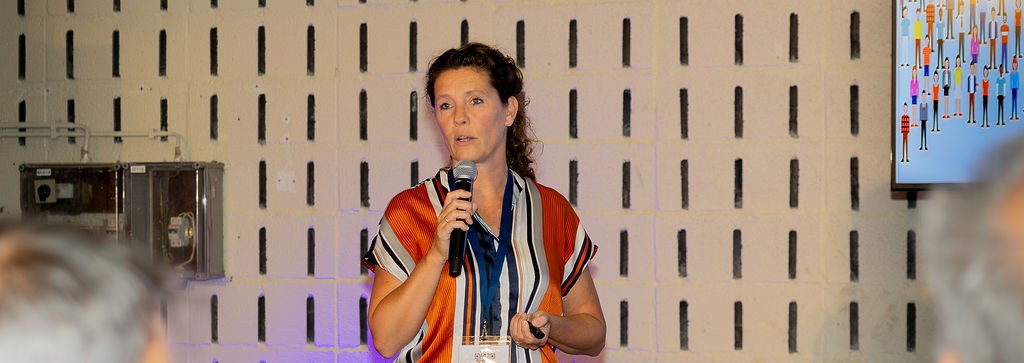How do you ensure efficient logistics in the city without compromising livability and safety? During the DMI day in Zwolle, Dana Zijlmans from the municipality and Robbert Janssen from DMI shared their insights. Zwolle is an inspiring example of how data, collaboration, and smart choices can lead to a future-proof supply chain.
Cities face an increasingly greater challenge: how do you combine a growing demand for logistics with the desire to keep cities livable, safe, and sustainable? Robbert Janssen, project leader for smart city logistics within the DMI ecosystem, outlines the playing field: “The zero-emission zone is the biggest policy issue in many cities, but much more is being worked on than that. Consider, for example, charging infrastructure, traffic filters, construction logistics, spatial utilization, and enforcement.”
Housing assignment
The housing challenge in the Netherlands also plays a role. Janssen: “Building houses also means an increase in vehicles, both during and after construction. Meanwhile, everyone has to get to work, including the workers on the construction site itself. Do construction workers travel together in a van, by public transport, or do they all travel individually? And how do you handle the large number of heavy construction vehicles that are added to the traffic? As a city, you have to consider this.”
Valuable insights
Zwolle is a prime example of a city tackling this challenge head-on. The city center is bordered by a canal and has only five access roads. Dana Zijlmans, a policy advisor for urban logistics at the municipality, explains how the city has been working on a zero-emission zone since 2020, in close collaboration with local stakeholders. “One of the first questions I asked when I started my job: ‘What exactly is coming into the city?’ We didn’t have any data on that. So we equipped the five access roads to the city center with cameras. These provided valuable insights: who drives into the city, with what type of vehicle, and how long are they staying?”
Large share of vans
The data showed, among other things, that delivery vans—often owned by freelancers such as plumbers, painters, and parcel delivery drivers—contribute significantly to logistics operations. Zijlmans: “This group of entrepreneurs is difficult to reach because they are generally not affiliated with industry organizations. At the same time, they are essential for supplying shops and providing services to residents.”
From insight to action
The insights from the monitoring provided a clear picture of where and at what times vehicles were present. It turned out that many vehicles entered the city without actually needing to be there – in other words, through traffic. “It also became clear that vehicles often entered the pedestrian zone within the designated time window, but then lingered longer. We received many complaints about this.”
Zwolle recently used this information to refine its policy and encourage the bundling of deliveries. An example of this is the collaboration between hospitality businesses and regional product manufacturers in the LastMileFresh initiative, which allows them to have their orders delivered together, rather than individually.
Collaboration as the key to success
Both Zijlmans and Janssen emphasize the importance of collaboration. Zwolle works closely with the province of Overijssel, local businesses, logistics brokers, and national networks like the DMI ecosystem. Janssen: “We try to help municipalities by pooling knowledge. The challenges are often similar, so why reinvent the wheel?”
Within the DMI network, 14 municipalities are now collaborating on smart urban logistics. They are collaborating on data collection, such as VESDI data from Statistics Netherlands (CBS) containing vehicle trip and load information. While the municipalities are all different, their challenges are similar. Thanks to this collaboration and data exchange, a richer picture of logistics flows is emerging, helping municipalities develop targeted policies.
Future-oriented and flexible
Zwolle is also looking ahead. The city is exploring alternative forms of delivery, such as water transport and parcel lockers. Although not everything is as developed yet, the municipality continues to experiment. Zijlmans: “We want to help entrepreneurs take steps, even if they’re not quite ready for electrification. Give it a try, is our motto.”
Zwolle’s approach demonstrates that urban logistics isn’t just a technical challenge, but also a communication one. It’s also about involving businesses, residents, and other stakeholders. And about the smart use of available data to inform decisions.
You can view the photos of the DMI day in Zwolle here.

2 gedachten over “Slimme bevoorrading voor een leefbare stad: Zwolle als voorbeeld”
De slides van deze presentatie zijn hier te vinden: https://dmi-ecosysteem.nl/?attachment=26989&document_type=document&download_document_file=1&document_file=6709
De slides van deze presentatie zijn hier te vinden: https://dmi-ecosysteem.nl/?attachment=26989&document_type=document&download_document_file=1&document_file=6709